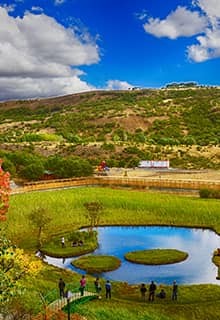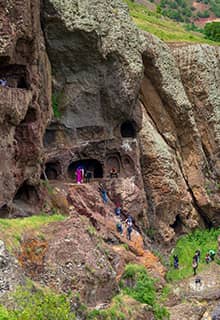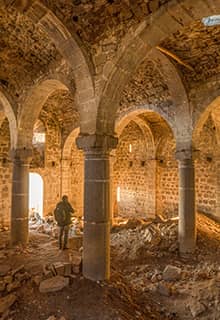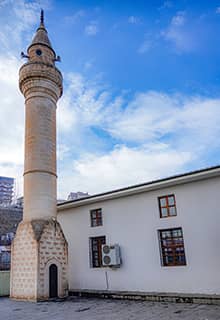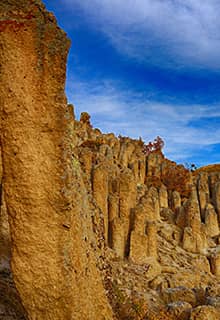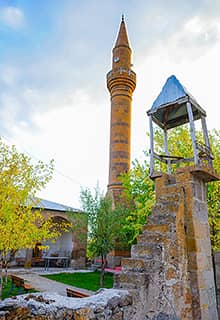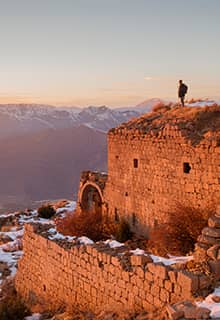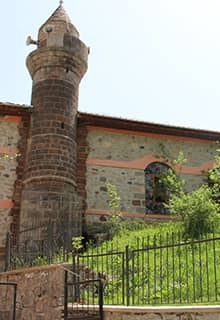see
Bingöl
Bingöl, located at the transition point between the provinces of Eastern Anatolia, harbors the traces of many civilizations that lived in the region with its location and its history dating back to 5,000 BCE. Bingöl has an untouched nature with its mountains, plateaus, plains, streams and lakes. Mosques from the 16th century, church and castle ruins from various periods are important historical riches of the city. In these respects, Bingöl appeals to everyone who loves history, nature and adventure.
Yüzen Islands
Yüzen Islands (Yüzen Adalar) consists of three islands that move independently on a completely natural crater lake surrounded by mountains on three sides. It is 4.5 km away from Bingöl -Solhan highway. The depth of the lake is more than 50 meters and is fed by a continuous stream of fresh water. The most distinctive feature of the lake is that the three islands in it move independently, like a raft, within the lake. The stunted ash trees on these islands also enhance the visual beauty of the Yüzen Islands. The water of the lake is sweet and clear.
Buban Fairy Chimneys
Buban Fairy Chimneys (Buban Peri Pacaları), located in Oğuldere Village in Sancak town, 50 kilometers away from the city center, are very important in terms of reflecting the diversity of natural beauty of Bingöl. For many years, the flood waters and wind descending from the slopes of the valley have created interesting pointed rock shapes in the form of fairy chimneys by eroding the rocks of tuff and created a natural wonder.
Zağ Rock Shelter Rooms
They are located on a steep rock, by the bank of Murat River. The four-storey shelter room carved into the rock is accessed by steps and a narrow road, also carved into the rock. In the four-storey Zağ Rock Shelter Rooms (Zağ Kaya Sığınak Odaları), there are different numbers and sizes of rooms on each floor.
It is thought that the rocks are of Urartu origin but were later used by Byzantine, Genoese and Persian civilizations. It is possible to visit about 30 rooms in Zağ Kaya Shelter Rooms.
İsfahan Bey Mosque
The mosque, which was built by Isfahan Bey in the Bingöl Aşağı Bazaar in the early 16th century, during the Akkoyunlu period, was built of cut stones in the Akkoyunlu architecture style. Although it has undergone many repairs due to earthquakes that have affected Bingöl over time, Isfahan Bey Mosque (İsfahan Bey Cami) is the only historical building in the city center.
Bağlarpınarı Village Mosque
Bağlarpınarı Village Mosque (Bağlarpınarı Köyü Cami), located in the middle of the historical cemetery, fountain and pool in Bağlarpınarı Village, is a building belonging to the Ottoman period and the date 1219 (CE 1809) is written on the mosque door. The inscription, which contains its history, contains geometric decorations, while the pulpit and mihrab inside the mosque are shaped with cut stones. The mosque and its column heads contain ornaments with plant motifs.
In the northeast corner of the mosque, there is also a historical cemetery shaped with cut stone workmanship.
Balaban Bey Mosque
Balaban Bey Mosque (Balaban Bey Cami), located in the district of Kiğı and with its history dating back to the Akkoyunlu period, is also known as Piltan Bey and Cami-i Kebir. The mosque, built in the early years of 1400s, is the oldest surviving mosque in Bingöl. There is a historical cemetery in the garden of the mosque and Akkoyunlu Bey Pir Ali Bey’s tomb is also located in the mosque.
Kral Kızı Castle
It is a castle built on a hill approximately 2-3 km east of the Genç district of Bingöl. It is named as “Dara Hini”, that is “Fountain of Dara” in the sources. It is among the rumors that the Kral Kızı Castle (Kral Kızı Kalesi) was built by the Persian ruler Dara for his daughter in the 7th century BC and Uzun Hasan of Akkoyunlu built for him when he married Despina (or Theodora), the daughter of the Trabzon Greek Emperor. Genç district takes its name from this castle, which is also known as “Genç Kalesi”.
Vank Church
The Vank Church (Vank Kilisesi), located on a high hill in the Vank hamlet, is thought to be at least 300 years old. The entrance (west) facade is covered with fine cut stone. The most prominent part of the church is the numerous cross signs engraved in different shapes and sizes on the stones on its door and on its ornate pediment. Two garlands with lion mouths were placed on the roof of the church, which is flat and covered with soil, so that the water that accumulates on the roof of the church can drain off, and this situation has given the church an architectural structure with a local character.
Kiğı Castle
It is also called as Şehitler Castle or Görgeç Castle. Kiğı Castle (Kiğı Kalesi) is thought to have been built during the Urartians period. The castle, also having architectural features of Byzantine-Ottoman, is on a very steep slope from the north and west directions. For this reason, the castle, having a magnificent view, is reached from the south direction.
Eskikavak Village Monastery
The history of Eskikavak Village Monastery (Eskikavak Köyü Manastırı), also known by the names of Nehre Nazır Saint Virgin or Yüksekteki Saint Virgin, goes back to the 14th century. The monastery has a beautiful view as it was built on a sloping land. and there are examples of stonework on cross motifs.
Kığı Adaklı Historical Sites
Located on the 20th kilometer of the Bingöl–Karlıova highway, the hot springs are accessible in both summer and winter. The facility includes one motel, one hotel, one guesthouse, three swimming pools (two of which are indoor), a restaurant, a tea garden, and a parking area.
The hot spring, known for its healing properties against various ailments, attracts significant attention from neighboring provinces. Water samples taken from the thermal pools in 1981 were analyzed by the Chemical Analysis Department of the Ankara Refik Saydam Central Institute of Hygiene and examined by the Physiotherapy and Hydrotherapy Clinic of Ankara Numune Hospital. The results showed that the water belongs to the group of bicarbonate, carbon dioxide, and carbonated mineral waters.
Zağ Rock Shelter Chambers
Zağ Cave is located on a steep cliff along the Murat River, between the villages of Gökçeli and Yenidal. The side facing the Murat River rises 200–300 meters above the ground and was carved directly into the rock.
The cave was built on three levels, each containing 26 rooms. The levels are connected by circular shafts, while doorways provide access between rooms. On the first level, there are wells believed to have been used as grain storage; the lower level contains living rooms, and the top level includes two chambers thought to have served as haremlik (private quarters). Although the cave has suffered some damage over time, 17 of its rooms still retain their original structure.
Buban Fairy Chimneys
Located in Oğuldere Village of the Sancak district in Bingöl, the Buban Fairy Chimneys attract attention for their resemblance to the famous fairy chimneys of Cappadocia in Nevşehir. These formations are waiting to be discovered by both domestic and international visitors.
Situated 50 kilometers from the city center, the Buban Fairy Chimneys stand out with their mysterious appearance. Locals in Bingöl consider them rivals to Cappadocia’s fairy chimneys. Although their exact formation process is unknown, they are believed to date back to ancient times. It is thought that the fairy chimney shapes were formed through the erosion of tuff structures by rainwater flowing down the valley slopes and by strong winds, resulting in these fascinating pointed rock formations.
